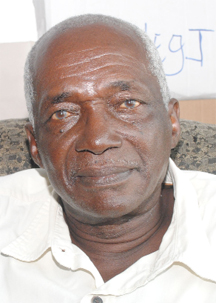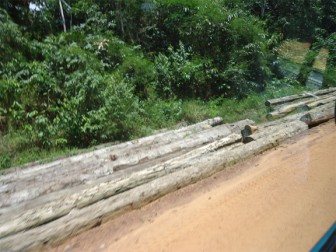– regeneration distant
A succession of hard knocks in recent years has set the country’s timber industry on a downward slide from which it is unlikely to recover in the short term, President of the Guyana Forest Producers Association (GFPA) Khellawan told Stabroek Business in an exclusive interview on Tuesday.
The GFPA top executive said he believed there has been some amount of shifting of investment from timber to gold coupled with which the forestry sector had lost much of its skills to the mining sector. “We can’t compete. An excavator operator who would earn around $200,000 in the forestry sector would earn up to $1 million in the gold industry. A cook could earn as much as $200,000.”
Khellawan said a point had been reached where training persons to work in the forestry sector might even have become counterproductive, since most of them would end up working in the gold industry anyway. He said the forestry industry had long been forced to resort to importing workers from Asia to ease the labour shortage in the local industry.
Meanwhile, Khellawan spoke of “a drastic decline in the production of logs”, which he said had led to importation to meet local market needs.

And according to former President of the FPA Hilbertus Cort the decline in the industry had been sufficiently severe to leave “a mere handful of the big players still in operation.” The others have been overcome by extreme depreciation in equipment and an inability to recapitalize. “The simple truth is that many of the major timber investors have simply not been able to stay in an industry that has not been able to afford to recapitalize in several years,” Cort said, adding that access to bank lending had been compromised by a loss of confidence in the industry. “We have not been able to provide the banks with bankable proposals, so that little has changed since around 1975. There has been no real re-tooling in the industry.”
Meanwhile, Khellawan said the forestry sector continues to be faced with the high costs associated with constructing roads in circumstances where gold miners benefited from access without having to share the costs. “Roads can cost up to $2 million per mile to build and the banks are not lending money for road-building,” Khellawan said.
He told Stabroek Business that while the gold and forestry sectors both extracted resources from the forests, he believed the gold industry had been able to secure a measure of leverage commensurate with its earnings.

According to Khellawan, the confidence of the forestry sector might have also been shaken by evidence of a decrease in the wood component of structures currently being built. He referred to recent innovations in the construction sector, which he said appeared to place more emphasis on concrete, metals and other material. “Whereas buildings used to comprise almost 100 per cent wood, it is now down to around 20 per cent in some cases,” Khellawan said.
According to Cort, the revival of the country’s forestry will depend heavily on the disposition of the stakeholders to “change the way in which the forestry sector is run.” Cort said that while it was highly desirable to focus on value-added, downstream forestry products, this could only be accomplished through the aggressive technological enhancement of the sector. “More than that,” Cort said, “it is difficult to go forward given the current overregulation of the sector.” The former FPA president bemoaned what he said was an absence of “serious research and species studies” in the local forestry sector. “We really should be aiming to place three new species on the market every year,” Cort said.
Khellawan, meanwhile, told Stabroek Business that it was difficult for the timber industry to begin to contemplate competitive downstream processing in the absence of cheaper electricity. “The reality is that we would never be able to compete with wooden imports from those countries that access cheaper sources of power,” Khellawan said.

Meanwhile the FPA officials told Stabroek Business that the association has tried for several years and with little success to focus the attention of the authorities on the need to create “a new model” for the management of the country’s timber industry. Khellawan told this newspaper that the advent of the Low Carbon Development Strategy had given rise to the necessity to re-think the approaches to optimizing production in the forestry sector, while being mindful of environmental considerations.
Cort told Stabroek Business, meanwhile, that the forestry sector was currently only just being kept afloat without any clear vision regarding the way forward.





